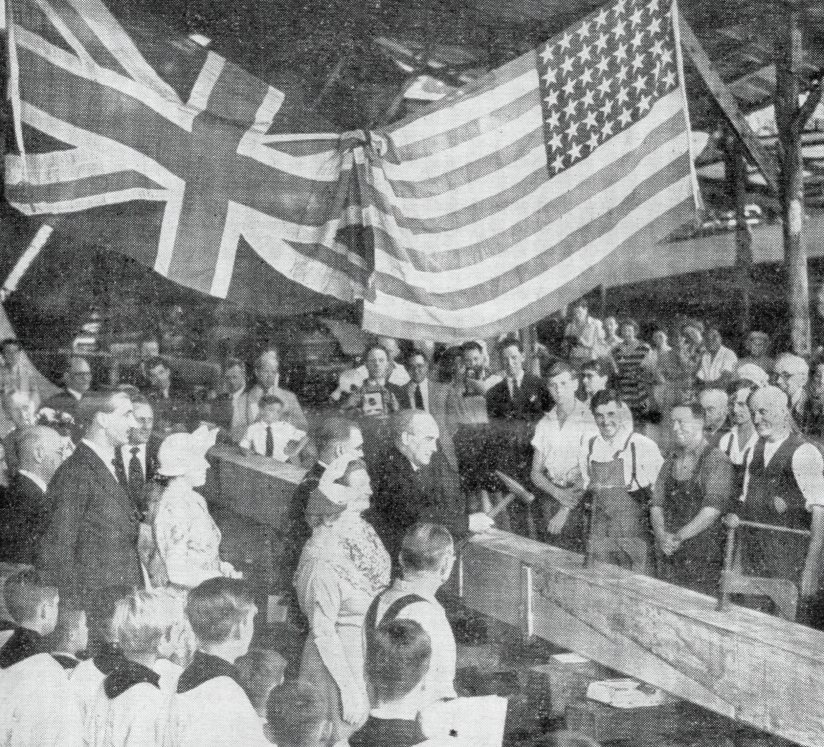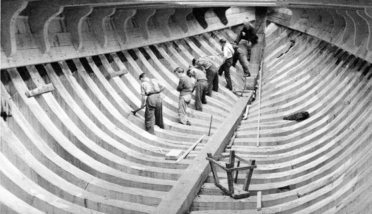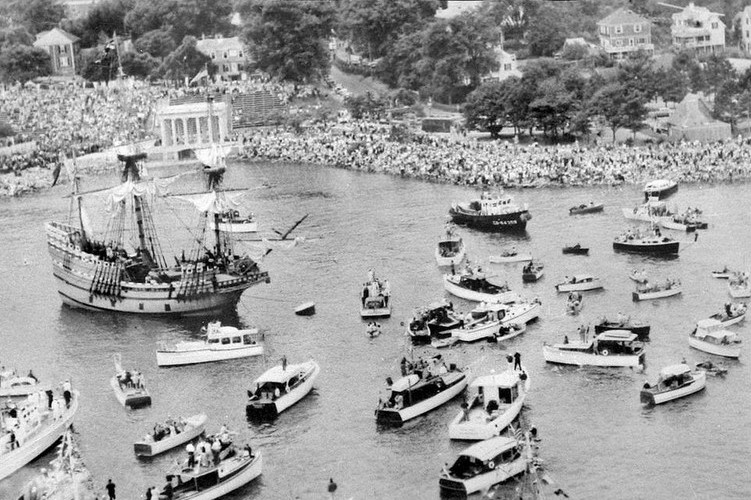*Guest post by Randal Charlton, author of The Wicked Pilgrim*
Warwick Charlton had successfully got his project to build and sail the Mayflower II off the ground. But, as the date of the launch grew ever nearer, new problems began to arise.
There was the question of insuring the ship. Warwick solved that one by telling the potential insurers that both he and the boat builder would be sailing on the Mayflower II. That should give them confidence, he observed. At the same time, he told the underwriters at Lloyds of London that he needed the policy written in the language of the 1600s and signed by each underwriting partner in ink.
Then a shipbuilding strike occurred, and Warwick had to use all his powers of persuasion to get the British national shipbuilding union to allow the construction of Mayflower II to continue while every other yard in the country fell silent.
Then a military invasion threatened the whole project. The British Government conspired with France and Israel to invade Egypt to take control of the Suez Canal – a vital shipping channel to the Indian ocean, which had been nationalized by Egyptian president Gamal Abdul Nasser. The British government had neglect to tell President Eisenhower of their plans. Eisenhower was furious. He was trying to lecture the Soviet Union about the need to recognize the sovereignty of Hungary and at the same time he was facing reelection.
The deceptively mild-mannered American president made his allies an offer they could not refuse – to get out of Egypt fast. The British retreated but the British public were upset with the lack of American support for their soldiers and that put an end to any thoughts of an appeal for public donations to raise the balance of funds to finish Mayflower II.
Throughout the seemingly never-ending drama of the fund-raising Warwick did not always make things easy for himself. He insisted on the building work being done using the tools of the time when the first Mayflower was constructed. Twentieth-century builders had to be trained to use old-fashioned tools.
Warwick also found it hard to listen to the advice of others including his quiet, almost silent partner, John Lowe. Lowe had organized the Mayflower II to go on exhibition at London Docks followed by Southampton which would have raised the funds to pay off remaining financial obligations but that meant a delay of a year in the sailing to America. But Warwick couldn’t wait. He had promised his American partners he would sail in 1957.

Commander Winslow ceremonially lays the keel of Mayflower II in Brixham – copyright Three Sisters Publishing Ltd
He also had little time for the British Government who in return had little time for him or his Mayflower project. Senior officials in the Department of Trade thought that Britain should be presenting its best new technology and that the arrival of a sixteenth-century sailing ship would send exactly the wrong message to the Americans.
In the end Warwick, desperate and exhausted, willed the ship to sail, and with 33 men and a cat aboard it arrived safely after 53 days at sea, in early June 1957. The entire world, or so it seemed, forgot their cares and followed its progress.
It was in an era dominated by the printed press and reports appeared daily in multiple languages around the world. Even when the ship was becalmed newspapers found something to write about: the religious beliefs of the early settlers, the Mayflower Compact, Mayflower fashions, Mayflower food, the Anglo-American connection.
Mayflower arrived at Provincetown on June 12, 1957 and there, with his trademark sense of history Warwick staged a reenactment of the original compact that was signed back 1620 aboard the original Mayflower.
A few days later Mayflower II was greeted by vice president Nixon, thousands of onlookers and enough media to report a major war. They reported the wonderful welcome but also the fact that Mayflower II had left England with some unpaid debts. My father was blamed of course.
Over the next two years Mayflower II sailed first to New York where my father had organized an exhibition then on to Miami before sailing back up to Washington DC before arriving at its permanent berth in Plymouth. Revenue from Mayflower’s exhibition paid off the remaining debts. Meanwhile, Mayflower Aero Transit sponsored my father on a two-year multi-state tour of the United States where he retold his Mayflower adventure and promoted the coming opening of the Pilgrim village by Plymouth Plantation. Then he returned to the UK with $15 in his pocket and resumed his career as a writer.
Since then over 25 million Americans have walked the wooden decks of Mayflower II and reconnected with their roots. Last September Mayflower II was relaunched after a multi-million-pound refit- not bad for a ship that exchanged hands for $1. The renovated ship was due to be at the center of celebrations of the 400-year anniversary of the first settlers arriving.
My father’s dream of helping to establish an Anglo-American scholarship program with surplus funds from Mayflower fees was never realized in his lifetime although to fulfill my father’s dream I have begun a small foundation in his name. One of the first Mayflower scholarships was awarded last year to students at the University of Plymouth in England. I hope there will be many more Anglo-American scholarships because I share my father’s belief that, in spite of the very different cultures on either side of the Atlantic, the peoples of North America and the United Kingdom share many common values. In particular we value personal freedom and democracy. I was born on December 31, 1939, at the start of the second world war and bizarrely, when I was less than a couple of days old, a picture of me appeared on the front page of the London Daily Express. I was being proudly held by my father in his newly acquired officer’s uniform. The fighting had not started in earnest but the story accompanying the picture, written by my father, began:
“What shall I tell my war baby son? Will he know who Hitler was? Will he care?”
The article went on to wonder what sort or society I would grow up in. After spending half my life in the UK and half in the United States, I thought it was time to answer the questions my father posed 80 years ago. In writing his biography, The Wicked Pilgrim, I have tried to capture my father’s colorful life in pursuit of his lofty ideals. This Mayflower man was the first to admit that, at times, he sailed pretty close to the wind.
The Wicked Pilgrim, the true story of the Englishman who gave Mayflower II to America, is published by Three Sisters Publishing Ltd. It is available at maritime museums and bookstores on both sides of the Atlantic. For details go to www.thewickedpilgrim.com


